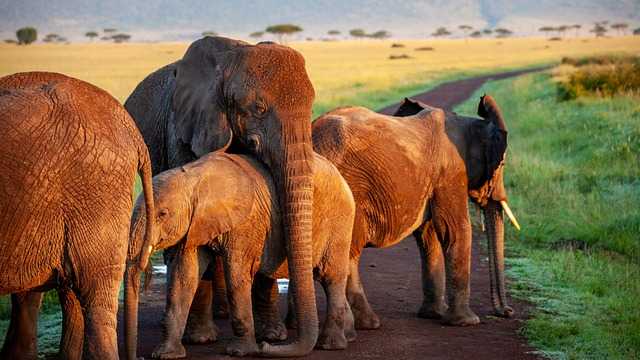Table of Contents
- Exploring the Rich Symbolism Behind Elephant Paintings
- Techniques and Styles: Mastering the Art of Elephant Depiction
- Choosing the Right Materials for Captivating Elephant Artwork
- Promoting Conservation Through Art: The Role of Elephant Paintings
- Q&A
- To Wrap It Up
Exploring the Rich Symbolism Behind Elephant Paintings
Elephant paintings have captivated art enthusiasts and casual observers alike, not just for their aesthetic appeal but also for the deep meanings they convey. These majestic creatures symbolize a plethora of concepts across various cultures, such as wisdom, loyalty, and strength. Each stroke in an elephant painting can represent the artist’s interpretation of these heavy themes, inviting the viewer to delve deeper into its significance.
The cultural significance of elephants serves as a foundation for many artistic representations. In Indian culture, for instance, elephants are revered as symbols of good fortune and prosperity, often associated with the Hindu god Ganesha. This belief has trickled down into the art, where elephant paintings often blend vibrant colors and intricate patterns to showcase their spiritual relevance.
There’s also a remarkable connection between elephants and environmental themes in contemporary art. Many artists utilize their canvases to highlight the plight of these gentle giants facing extinction. By embedding elements of their natural habitat within the artwork, they raise awareness about conservation efforts. Such pieces not only beautify a space but also tell a poignant narrative about the need for eco-preservation. Artists employ techniques such as layering and texturing to bring these issues to life on canvas.
| Symbolism | Cultural Interpretation |
|---|---|
| Wisdom | Often associated with longevity and experience, elephants represent knowledge. |
| Loyalty | These animals are known for their deep familial bonds, representing steadfastness. |
| Strength | Elephants are considered powerful creatures, symbolizing resilience. |
| Good Fortune | In many cultures, images of elephants are believed to attract luck and success. |
Ultimately, the allure of elephant paintings lies in their ability to weave multiple narratives—a blend of personal, cultural, and environmental storytelling. Each piece invites the audience to not only engage visually but to also explore the underlying messages and emotions conveyed through the art. As a result, elephant paintings stand as a rich tapestry of artistic expression, resonating with viewers on multiple levels.


Techniques and Styles: Mastering the Art of Elephant Depiction
When painting elephants, artists have a myriad of techniques at their disposal, each offering a unique approach to capturing these magnificent creatures. Acrylics are a popular choice due to their vibrant colors and quick drying time, allowing for layering without long waits. Watercolors, on the other hand, lend a soft and ethereal quality to the artwork, perfect for capturing the gentle grace of elephants. For those seeking rich textures, oil paints provide a depth that is hard to replicate, enabling the artist to create realistic fur and skin details.
Choosing the right style is equally essential in depicting elephants. Some artists lean towards realism, ensuring every wrinkle and strand is meticulously rendered, while others may opt for impressionism, focusing on color and emotion rather than explicit detail. Abstract techniques also open up new possibilities, allowing one to experiment with shapes and forms that evoke the spirit of the elephant without being bound to reality. Each style can tell a different story, connecting the viewer with the art on various levels.
Incorporating different mediums and tools can further elevate the depiction of elephants. Mixed media techniques can add layers of complexity and interest to your artwork. Consider combining traditional paint with digital elements or using collage techniques to bring in textures and patterns that accentuate the subject. To facilitate the creative process, artists can benefit from having a reference board filled with photographs and other elephant artworks—an invaluable resource for inspiration.
| Technique | Benefits |
|---|---|
| Acrylics | Vibrant colors, fast drying time |
| Watercolors | Soft and ethereal effect |
| Oils | Depth and richness of color |
| Mixed Media | Variety of textures and elements |


Choosing the Right Materials for Captivating Elephant Artwork
Choosing the right materials for creating enchanting elephant artwork can significantly impact both the process and the final outcome. Mediums such as acrylics, watercolors, and oil paints each offer unique characteristics that can enhance your depiction of these magnificent creatures. Acrylics, for instance, are known for their quick drying time and versatility, allowing artists to layer and blend colors effortlessly. Watercolors can provide a translucent quality, perfect for soft edges and ethereal backgrounds, while oil paints can create depth and richness that bring an elephant to life with a striking allure. Another essential component of captivating elephant artwork is the canvas or paper you choose. While traditional stretched canvas is popular for acrylic and oil paintings, consider using heavyweight watercolor paper if you opt for watercolors. The texture of the paper can add an extra dimension to your work, capturing details in the elephants’ skin that mimic nature beautifully. Here are some popular options classified by medium:- Cotton Canvas: Durable and ideal for acrylics and oils
- Watercolor Paper: Perfect for watercolor techniques
- Wood Panels: Great for mixed media and offers a solid surface
| Type of Pigment | Characteristics |
|---|---|
| Organic Pigments | Vibrant and lightfast, ideal for bright colors |
| Inorganic Pigments | Rich in opacity, perfect for muted tones |
| Metallic Pigments | Adds shimmer and dimensionality for accentuating details |


Promoting Conservation Through Art: The Role of Elephant Paintings
Art has a profound ability to connect with people on an emotional level, making it a powerful tool for conveying important messages about wildlife conservation. Among the various artistic expressions, elephant paintings have emerged as a unique medium that highlights the beauty of these magnificent creatures, drawing attention to the threats they face in their natural habitats. These colorful masterpieces, created with the assistance of elephants, serve not only to entertain but also to educate the public about conservation efforts and the pressing need to protect endangered species.
One of the most compelling aspects of elephant paintings is that they allow these animals to participate in the creative process, showcasing their intelligence and dexterity. Through gentle encouragement and training, elephants can create stunning artwork, which often reflects their surroundings and experiences. This collaboration between human and animal blurs the lines of traditional art creation, inviting viewers to reconsider their relationship with wildlife. When people witness elephants creating art, they may feel a deeper connection to these creatures and, in turn, be inspired to support conservation initiatives.
Furthermore, the sale of elephant paintings can generate significant funds for wildlife conservation organizations. By purchasing these artworks, enthusiasts contribute directly to the welfare of elephants and their habitats. Many organizations use proceeds from these sales to support anti-poaching efforts, habitat restoration projects, and education programs for local communities. In this way, elephant paintings serve not only as artistic expressions but also as tools for fundraising and awareness, fostering a sense of responsibility towards environmental stewardship.
To effectively promote these efforts, it’s essential to leverage various channels such as art exhibitions, social media campaigns, and community events. Engaging with the audience through interactive exhibits allows people to understand the importance of conservation while appreciating the artistry involved. Here are some strategies that can enhance promotional activities:
- Host Live Painting Events: Organize events where elephants can showcase their painting skills, drawing crowds and media attention.
- Create Social Media Campaigns: Utilize platforms like Instagram and Facebook to share behind-the-scenes footage, testimonials, and success stories related to conservation efforts.
- Collaborate with Artists: Partner with local and international artists to create exclusive pieces that blend traditional art styles with the unique touches provided by elephants.
- Offer Workshops: Conduct workshops that educate participants about elephant behavior and the importance of conservation while allowing them to try their hand at painting.
